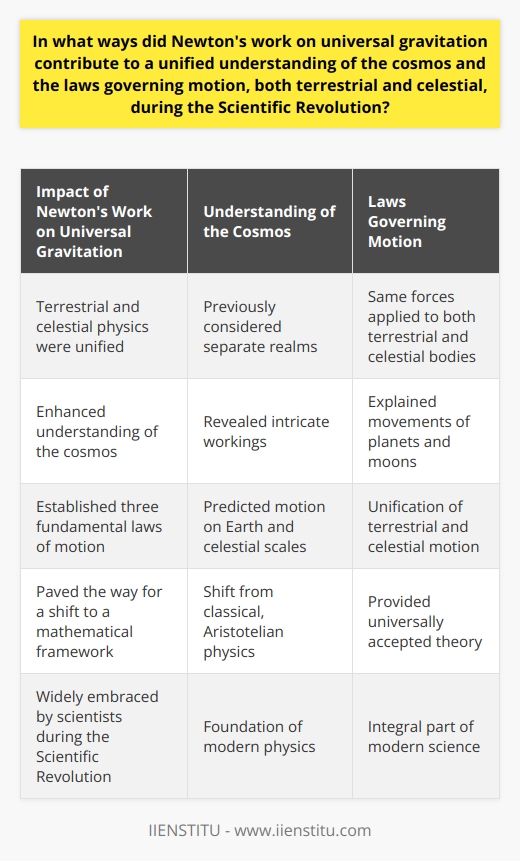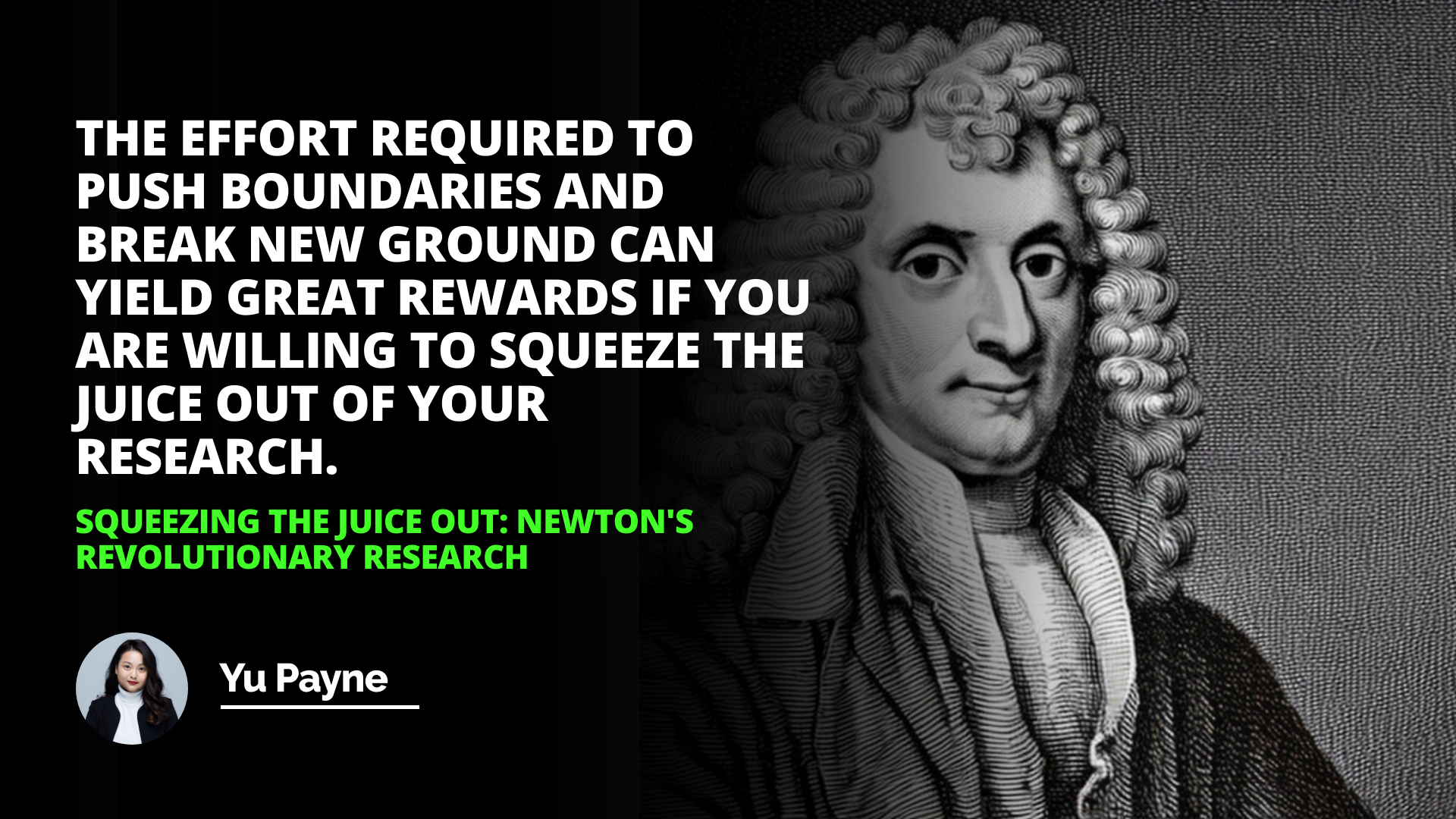
I remember the first time I heard about Sir Isaac Newton in my high school physics class. Our teacher, with a glint in his eye, dropped an apple on the floor—a cheeky nod to the legend we've all come to associate with Newton. Little did I know then how profoundly this 17th-century scientist would impact not just the world of physics, but my own understanding of the universe. Newton wasn't just a man of extraordinary intelligence; he was a visionary whose work continues to resonate through the halls of science and beyond.
A Humble Beginning with Grand Aspirations
Born on a quiet Christmas Day in 1642 in Woolsthorpe, England, Newton's early life didn't hint at the monumental legacy he would leave behind. Growing up in a rural farming community, the young Newton was more inclined towards tinkering with mechanical devices than tilling the fields. I often think about how many great minds start in the most unassuming places—it's a comforting thought, isn't it?
Newton originally studied to become a minister, attending the University of Cambridge. But fate had different plans. It was here that his fascination with the sciences truly blossomed. Surrounded by the works of Galileo Galilei and Johannes Kepler, Newton began to see the universe not just as a divine creation but as a complex machine governed by discernible laws.
The Catalyst: An Era of Scientific Revolution
The 17th century was a time of incredible change—a real history of scientific revolution. Scholars were challenging old notions and embracing new ways of thinking. Newton didn't just ride this wave; he became one of its most significant contributors. Inspired by his predecessors, he started to ask questions that no one else was asking.
What forces govern the motion of celestial bodies?
How does light behave under different conditions?
Can mathematics be used to explain natural phenomena?
These weren't just idle musings. Newton was laying the groundwork for theories that would redefine science.
Unveiling the Laws That Govern Us All
One of Newton's most remarkable achievements was formulating the three laws of motion, which he detailed in his seminal work, Philosophiæ Naturalis Principia Mathematica. I recall poring over these laws during my college days, amazed at how they could so elegantly explain everything from a rolling ball to the orbit of planets.
1- Law of Inertia: An object at rest stays at rest, and an object in motion stays in motion unless acted upon by an external force.
2- Law of Acceleration: The acceleration of an object is directly proportional to the net force acting upon it and inversely proportional to its mass.
3- Law of Action-Reaction: For every action, there's an equal and opposite reaction.
These laws weren't just theoretical; they were practical tools that could predict the movement of objects both on Earth and in the cosmos. Newton's laws of motion became the bedrock upon which classical mechanics is built.
The effort required to push boundaries and break new ground can yield great rewards if you are willing to squeeze the juice out of your research.
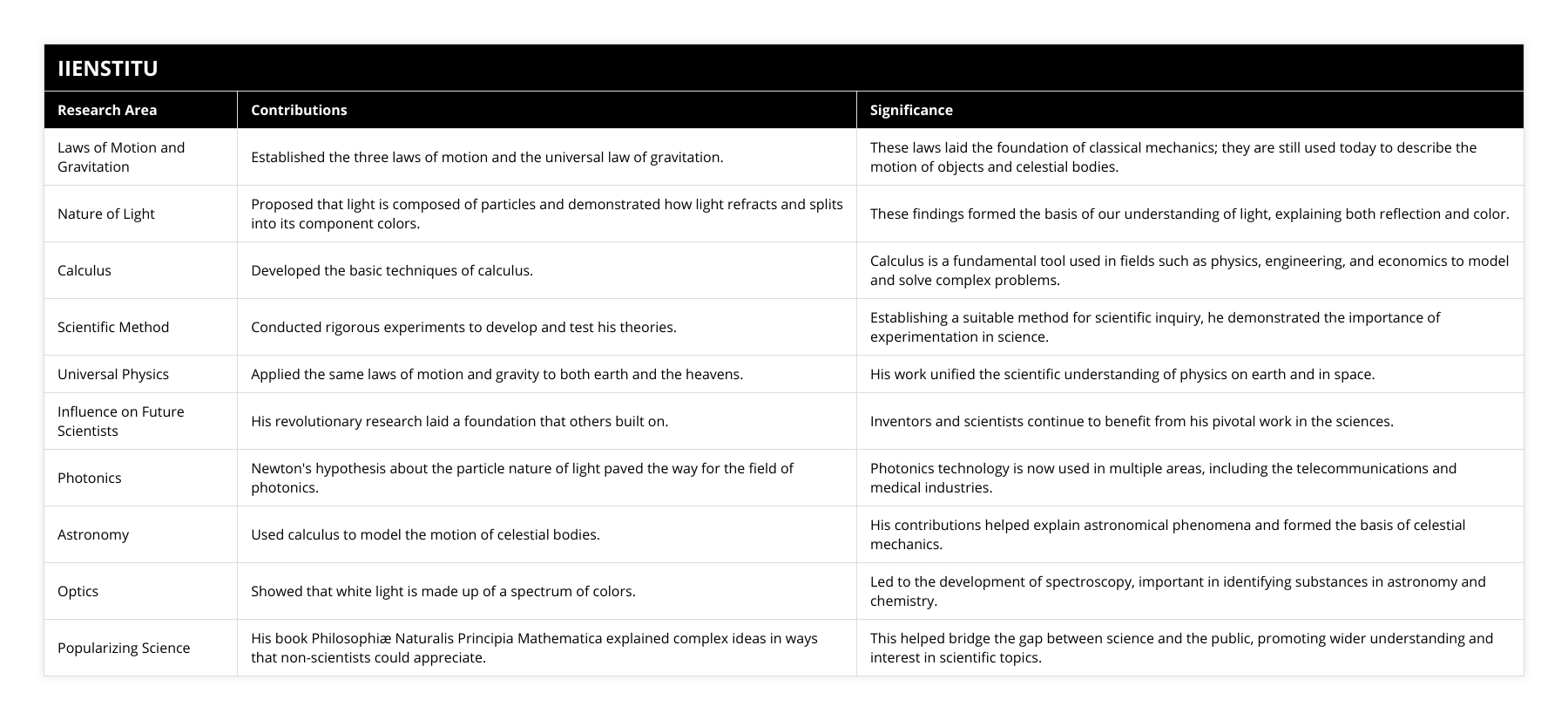
The Universal Law of Gravitation
Perhaps even more groundbreaking was Newton's theory of universal gravitation. Building on his laws of motion, he proposed that every mass attracts every other mass in the universe, a force that is proportional to the product of their masses and inversely proportional to the square of the distance between their centers.
This wasn't just about apples falling from trees (though that makes for a delightful story). Newton's law of gravitation provided a unified explanation for both earthly and celestial phenomena. It explained:
The orbits of planets around the sun.
The tides influenced by the moon.
The trajectory of comets through the solar system.
It's mind-boggling to think how one principle could unlock so many secrets of the universe.
Shedding Light on... Well, Light!
Newton didn't stop there. His curiosity led him to explore the nature of light and color. Using a simple prism, he demonstrated that white light is actually composed of a spectrum of colors. This experiment was revolutionary. Before Newton, the prevailing belief was that the prism colored the light. But he showed that the prism merely separated the colors already present within white light.
I tried replicating this experiment in a darkened room with a flashlight and a glass of water. Let's just say my results were less than spectacular! But it gave me a newfound appreciation for Newton's meticulous methods.
The Dual Nature of Light
Newton proposed that light was made up of particles, or "corpuscles" as he called them. While this particle theory would later be debated, with wave theory gaining prominence, modern quantum mechanics has shown that light indeed has a dual nature, exhibiting both particle-like and wave-like properties. Newton was, once again, ahead of his time.
Calculus: A New Mathematical Language
Now, let's talk about calculus. Just hearing the word might bring back memories of late-night study sessions and complicated problem sets. But imagine inventing it! Newton developed the basic techniques of calculus to solve problems related to motion and change. Independently, Gottfried Wilhelm Leibniz was developing similar ideas. This led to a famous dispute over who invented calculus first—a debate that historians still discuss today.
Calculus became an indispensable tool in mathematics, physics, engineering, and beyond. It allows us to:
Calculate rates of change.
Determine the area under curves.
Model natural phenomena like the growth of populations or the decay of radioactive materials.
In essence, calculus opened up new avenues for scientific exploration and technological advancement.
The Human Side of a Genius
What's often overlooked is Newton's personality and personal journey. He wasn't just a distant figure churning out theories; he was a complex individual with quirks and struggles. Newton was known to be deeply introspective, sometimes to the point of isolation. He had intense rivalries—most notably with Leibniz—and was fiercely protective of his work.
But perhaps this is what made him so relatable. We've all had moments where we're so engrossed in a project that we lose track of time, or felt the sting of someone else taking credit for our ideas. Newton's relentless pursuit of knowledge, despite the obstacles, is truly inspiring.
Lessons from Newton's Dedication
In today's fast-paced world, we're often juggling multiple responsibilities. Whether it's pursuing an online human resources management certificate program to advance our careers or learning a new skill for personal growth, Newton's dedication reminds us that deep focus and perseverance can lead to remarkable achievements.
Newton's Lasting Impact on Modern Science
The ripple effects of Newton's work are so vast that they touch virtually every aspect of modern science. His theories set the stage for future scientists like Albert Einstein, who would build upon and challenge Newtonian physics with the theory of relativity.
Some of Newton's lasting contributions include:
Providing a framework for classical mechanics.
Influencing the scientific method with his emphasis on experimentation and mathematical analysis.
Contributing to the Enlightenment, a period where reason and science took center stage in society.
A Toolbox for Understanding the Universe
Newton didn't just give us laws and equations; he provided tools—a toolbox of knowledge—that continues to help us understand, predict, and shape our world. His work in mathematics and physics allows engineers to build bridges, astronomers to discover new planets, and even helps us navigate using GPS technology.
Bringing It All Together
Reflecting on Newton's life and achievements, I'm struck by how one person's curiosity and determination can change the world. His story encourages us to:
1- Stay Curious: Never stop asking questions about how things work.
2- Embrace Challenges: Difficult problems often lead to the most rewarding solutions.
3- Share Knowledge: Newton built upon the work of others and was part of a broader scientific community.
In our own lives, we can take these lessons to heart. Whether we're delving into the complexities of physics or embarking on a new career path through an online human resources management certificate program, the key is to remain committed to our goals.
The Juice Worth Squeezing
As the saying goes, "The effort required to push boundaries and break new ground can yield great rewards if you are willing to squeeze the juice out of your research." Newton exemplified this. He didn't shy away from hard work or complex problems. He squeezed every drop of insight he could from his studies, and in doing so, quenched humanity's thirst for understanding the universe.
References
Gleick, James. Isaac Newton. Vintage Books, 2004.
Westfall, Richard S. Never at Rest: A Biography of Isaac Newton. Cambridge University Press, 1983.
Newton, Isaac. The Principia: Mathematical Principles of Natural Philosophy. Translated by I. Bernard Cohen and Anne Whitman, University of California Press, 1999.
Fara, Patricia. Newton: The Making of Genius. Pan Macmillan, 2002.
Whiteside, D. T. The Mathematical Papers of Isaac Newton. Cambridge University Press, 1967.
In the end, Newton's journey teaches us that persistence and passion are essential ingredients in the pursuit of knowledge. So let's carry that spirit forward—who knows what discoveries await us when we're willing to look a little closer, think a bit harder, and reach a little further?
Frequently Asked Questions
What were Isaac Newton's most significant contributions to science?
Isaac Newton made significant contributions to the field of science during his lifetime. Perhaps the most well-known are his three laws of motion. These laws describe how objects move in the universe and the forces that affect their activity. The first law states that an object at rest will stay at rest, and an object in motion will continue moving in a straight line at a constant speed unless acted upon by an external force. The second law describes how the force acting on an object equals the object's mass times its acceleration. Finally, the third law states that for every action, there is an equal and opposite reaction.
In addition to the laws of motion, Newton also discovered the universal law of gravitation. This law describes the gravitational force between any two objects with mass. According to this law, everything in the universe attracts every other thing with a point proportional to the product of their groups and inversely proportional to the square of the distance between them. This law explains the motion of planets in our solar system and the movement of galaxies throughout the universe.
Newton also made significant contributions to the study of light and optics. For example, he discovered that light is composed of particles and developed the concept of refractive index. In addition, Newton showed that when light passes through a prism, it splits into its component colors, revealing that light has a dual nature and can be described by science.
Finally, Newton developed calculus, a mathematical system that provides a new way to explain the behavior of natural phenomena. Today, calculus is widely used in mathematics and physics, allowing scientists to model complex systems and predict their behavior.
Newton's contributions to science were immense and revolutionized our understanding of natural phenomena. His theories and discoveries continue to influence modern physics, mathematics, and engineering, and his legacy lives on as one of the greatest scientific minds in history.
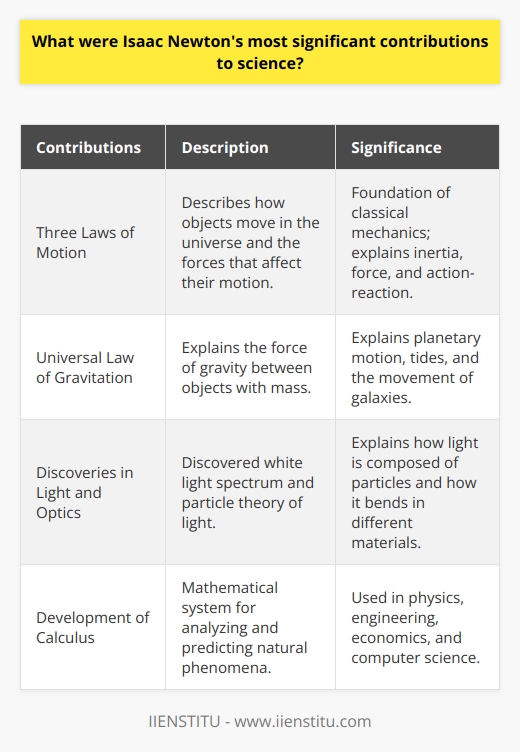
What inspired Isaac Newton to pursue science?
Isaac Newton's interest in science and mathematics began as a student at the University of Cambridge. He was exposed to the works of other influential scientists, such as Galileo Galilei and Johannes Kepler, who were already making significant contributions to the field. Newton was interested in the laws of motion and gravity and began developing his ideas about these concepts.
One of Newton's most notable scientific contributions famous was his development of the laws of motion, which he laid out in his renowned book Philosophia Naturalis Principia Mathematica. These laws, including the law of inertia, the law of linear momentum, and the law of action-reaction, provided a comprehensive framework for understanding the universe's mechanics. Newton also introduced the universal law of gravitation, which states that all bodies of mass attract each other and act according to the universal law of gravitation. This law accurately explains the movement of planets, stars, and other celestial objects.
In addition to his work on motion and gravity, Newton conducted groundbreaking light research. He proposed that light was composed of particles, which we now know as photons. He also demonstrated that light refracts when it passes through a prism and splits into its component colors. This elegant experiment was the first to show that light has a dual nature and can be described by science.
Perhaps Newton's most enduring contribution to mathematics was his invention of calculus. Calculus is a branch of mathematics that deals with the study of rates of change and continuous motion. Newton developed the basic techniques of calculus, which are still used today in the sciences and engineering. He also used calculus to model the movement of planets and other celestial bodies, providing a new way to explain the behavior of natural phenomena.
In summary, Isaac Newton's interest in science was sparked during his time at the University of Cambridge, where the works of other influential scientists inspired him. He went on to develop his theories and experiments, which led to groundbreaking discoveries in motion, gravity, light, and mathematics. Newton's contributions to science continue influencing and shaping our understanding of the natural world today.

How did Isaac Newton's work influence modern science?
Isaac Newton's contributions to science are vast and have revolutionized our understanding of the natural world. Perhaps his most famous work is his formulation of the three laws of motion, which describe the behavior of objects in action. The first law states that an object at rest will remain at rest, and an object in motion will remain in action at a constant velocity unless acted upon by an external force. The second law states that the force applied to an object is proportional to the object's mass and acceleration. Finally, the third law states that for every action, there is an equal and opposite reaction.
Newton's law of gravity is also a fundamental concept in modern physics. He formulated the law of universal gravitation, which states that every object in the universe is attracted to every other thing with force directly proportional to the product of their masses and inversely proportional to the square of the distance between them. This law has been used to explain planets' motion, satellites' behavior, and galaxies' dynamics.
Newton's work on optics also significantly contributed to our understanding of light. He showed that white light is composed of different colors and can be refracted and reflected. Newton used a prism to demonstrate the separation of light into its component colors and developed the first reflecting telescope.
In addition to his groundbreaking work in physics, Newton also developed calculus, a branch of mathematics used to solve problems involving rates of change and quantities that are constantly changing. Calculus is used in a wide range of fields, including engineering, economics, and biology, to name a few.
Overall, Isaac Newton's work laid the foundation for modern physics and mathematics, providing a framework for understanding the natural world that continues to be used today. His contributions to science have been fundamental to the development of many fields, and his legacy as one of the most significant scientists in history continues to inspire future generations.
What were the key elements of Newton's research that transformed our understanding of the natural world during the Scientific Revolution?
**Newton's Contributions to the Scientific Revolution**
One crucial component of Newton's research that transformed our understanding of the natural world was his development of the three laws of motion. These laws not only provided a foundation for classical mechanics but also offered a comprehensive description of the relationship between an object's motion and the forces acting upon it. The first law of motion, known as the law of inertia, highlights the natural tendency of an object to maintain its current state of motion. The second law presents an equation connecting the net force applied to an object, its mass, and its acceleration, while the third law highlights the equal and opposite reaction to every action in nature.
Another notable achievement of Newton's research was his law of universal gravitation, which established the force that governs the motion of everything in the cosmos, from planets to falling apples. This law states that every particle in the universe attracts every other particle with a force that is directly proportional to the product of their masses and inversely proportional to the square of the distance between them. By demonstrating that gravity is a universal force acting upon all entities, Newton managed to unify the terrestrial and celestial realms, effectively merging the study of astronomy and physics.
Moreover, Newton's invention of calculus further revolutionized the natural sciences by providing a powerful mathematical tool to analyze and represent various aspects of the physical world. Calculus assists in understanding the behavior of phenomena involving continuous change, such as the motion of planets, the flow of fluids, or the varying properties of matter, enabling scientists to model real-world systems accurately. As a result, Newton's research in mathematics delivered a critical tool for scientists to quantify and predict the behavior of diverse natural phenomena successfully.
Within the realm of optics, Newton's groundbreaking experiments and discoveries also had a significant impact on our comprehension of the natural world. His work on light proved that white light could be separated into a spectrum of colors, and he elucidated that the color of an object depends on the selective absorption, transmission, and reflection of these spectral components. Furthermore, his creation of the reflecting telescope, which relies on mirrors to gather and focus light, greatly enhanced the capacity for astronomical observations and contributed to a deeper understanding of celestial bodies.
In conclusion, Newton's research into the laws of motion, universal gravitation, calculus, and optics played a pivotal role in transforming our understanding of the natural world during the Scientific Revolution. By unifying disparate areas of inquiry and providing innovative tools to explore and describe the universe, his genius laid the foundation for modern science and solidified his position as an incomparable scientific figure.

In which experiment did Newton famously explore the nature of light and how it relates to color perception?
Newton's Prism Experiment
Sir Isaac Newton is renowned for his groundbreaking experiment in the 1660s that delved into the nature of light and its connection to color perception. This famous experiment involved the use of a prism, a triangular glass object capable of dispersing light into its constituent colors, a phenomenon known as dispersion.
The Setup
Newton's experiment was designed around a simple yet effective setup. He darkened a room and created a small hole in a window shutter, allowing a beam of sunlight to enter. He then positioned the prism in the path of this sunlight, causing the beam to refract and be redirected onto a white surface, revealing the spectrum of colors that constitute white light.
The Discovery
Newton's findings from this experiment were groundbreaking in understanding the nature of light and colors. By observing the spectrum of colors on the white surface, he deduced that white light is a combination of multiple colors. Moreover, he discovered that the arrangement of colors (red, orange, yellow, green, blue, indigo, and violet), later known as the visible spectrum, is consistent and unchangeable.
Further Investigations
As Newton continued to examine his experiment, he found that by reconverging the separated colors with a second prism, the resulting light would return to its initial white form. This observation confirmed that colors were not created by the prism or any other potential factors, but preexisted within the white light itself. Additionally, Newton explored the idea that colors differed in their degrees of refrangibility, or their ability to bend when passing through a medium. He found that each color corresponds to a specific degree of refrangibility, with red being the least refrangible and violet being the most.
The Legacy
Through his renowned prism experiment, Newton contributed significantly to the understanding of light and color, paving the way for future discoveries in optics and color theory. His findings directly challenged the contemporary notion that white light was pure and unchanging, and ultimately revolutionized the scientific community's perception of the nature of light.
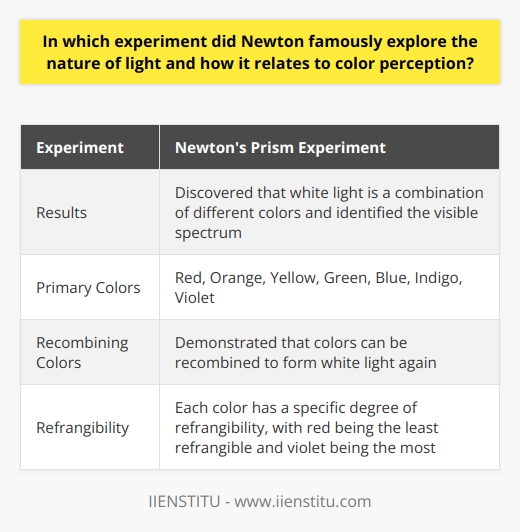
Can you provide an overview of who Isaac Newton was and the fundamental discoveries he introduced in the fields of physics, mathematics, and optics?
Early Life of Isaac Newton
Isaac Newton was an English mathematician, physicist, and astronomer who was born in 1643 in Woolsthorpe, Lincolnshire. He is a key figure in the scientific revolution, having made significant contributions to multiple fields of study.
Physics: Laws of Motion and Universal Gravitation
In the field of physics, Newton presented the groundbreaking laws of motion and the law of universal gravitation. First, his three laws of motion lay the foundation for classical mechanics, explaining how an object in motion reacts to applied forces. Second, the law of universal gravitation states that every object in the universe attracts every other object with a force that depends on their masses and the distance between them.
Mathematics: Calculus
Newton further revolutionized mathematics with the development of calculus, a branch of math that deals with the study of change and motion through derivatives and integration. Calculus has numerous applications in various fields, such as physics, engineering, and economics, making it an indispensable aspect of modern mathematics.
Optics: Theories of Light
In the realm of optics, Newton discovered that white light is composed of various colors, which can be separated by a prism. He also proposed a corpuscular theory of light, which suggested that light consists of particles, called corpuscles. This theory, while eventually replaced by the wave theory of light, provided crucial insights into the nature of light and laid the foundation for future discoveries.
Conclusion
In conclusion, Isaac Newton was an extraordinary individual who significantly impacted the realms of physics, mathematics, and optics. His work laid the foundation for modern science, and his discoveries remain an essential part of our understanding of the natural world.
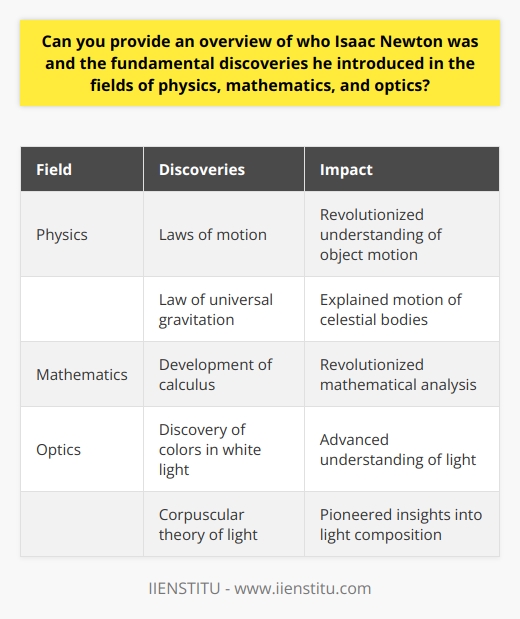
What did Newton contribute to the Scientific Revolution?
Significance of Newton's Contributions:
Undoubtedly, Sir Isaac Newton's contributions to the Scientific Revolution played a pivotal role in shaping the modern scientific landscape. His works significantly impacted various scientific disciplines, offering groundbreaking theories and principles that remain applicable today.
Mathematical Innovations:
Notably, Newton's development of infinitesimal calculus allowed scientists to describe the world with unprecedented precision. Calculus provided a mathematical tool capable of solving problems related to motion, area, and volume that were previously unsolvable. This enabled researchers to address complex scientific queries effectively and accurately.
Laws of Motion:
Newton's three laws of motion fundamentally transformed our understanding of the universe, unveiling the mechanisms governing motion. His first law introduced the concept of inertia, while his second law established the relationship between force, mass, and acceleration. Finally, Newton's Third Law detailed action and reaction forces, elucidating the principles of interaction among objects. These groundbreaking ideas laid the foundation for classical mechanics and have since been applied across a broad spectrum of scientific contexts.
Universal Gravitation:
Perhaps the most famous of Newton's contributions was his law of universal gravitation. Through this revolutionary concept, he established that every point mass attracts every other point mass through a force proportional to the product of their masses and inversely proportional to the square of their distance. By unifying terrestrial and celestial motion under the same gravitational principles, Newton's work provided a coherent explanation for the behavior of celestial bodies. This insight sparked a new era of scientific inquiry, unraveling the mysteries of the cosmos and paving the way for modern astrophysics and cosmology.
Optics and Light-Related Discoveries:
In addition to his work on motion and gravitation, Newton made groundbreaking contributions to optics, investigating the nature of light, colors, and perception. He discovered that white light is composed of multiple colors, which he observed through the dispersion of light via a prism. Newton also developed the first reflecting telescope, considerably improving astronomical observations and contributing to advancements in understanding the universe. His work in the field of optics has continued to exert substantial influence on contemporary photonic technologies and devices.
Conclusion:
In essence, Newton's revolutionary contributions to the Scientific Revolution transformed the trajectory of scientific progress. His ideas and discoveries have had a profound and lasting impact on a wide array of scientific disciplines and continue to shape modern scientific thought and understanding.

Who was Newton and what new research did he put forth?
**Sir Isaac Newton: An Introduction**
Sir Isaac Newton was a prominent English mathematician, physicist, and astronomer born in 1642. Regarded as one of the most influential scientists of all time, Newton made significant contributions to multiple fields of study.
**Foundations of Classical Mechanics**
Newton's most renowned research involves his formulation of the three laws of motion, which laid the groundwork for classical mechanics. The first law, also known as the law of inertia, states that an object at rest remains at rest, and an object in motion continues in motion with a constant velocity unless acted upon by a net external force. The second law reveals the relationship between an object's mass, its acceleration, and the net force applied. Lastly, the third law states that every action has an equal and opposite reaction.
**Universal Law of Gravitation**
Newton's discovery of the universal law of gravitation marked another significant breakthrough in scientific understanding. This law states that all objects in the universe attract each other with a force proportional to the product of their masses and inversely proportional to the square of the distance between their centers. In simple terms, objects with more significant mass exert a stronger gravitational pull on each other, while the gravitational force weakens as they move further apart.
**Calculus and Mathematics**
In addition to his seminal work in physics, Newton was also one of the key inventors of calculus, an essential branch of mathematics. He developed the method of fluxions, a precursor to infinitesimal calculus, to explain several mathematical processes, including the calculation of slopes on curves and areas enclosed by curves. By doing so, he established fundamental principles underpinning modern calculus, extending the tools available for engineers and scientists to tackle more complex problems.
**Optics and the Nature of Light**
Newton's study of human vision and light's nature constitutes another area of significant research. In his book 'Opticks,' he proposed that light comprises particles, or 'corpuscles,' which led to the development of the corpuscular theory of light. Although this theory later yielded to the wave theory of light, recognizing that light has particle-like properties laid the foundation for the modern understanding of light as having both wave-like and particle-like qualities.
In conclusion, Sir Isaac Newton's groundbreaking research contributed significantly to numerous scientific fields, including classical mechanics, mathematics, and optics. His work has left an enduring legacy as the basis for centuries of scientific advances, with his ideas and principles continuing to facilitate understanding and discovery in the modern era.
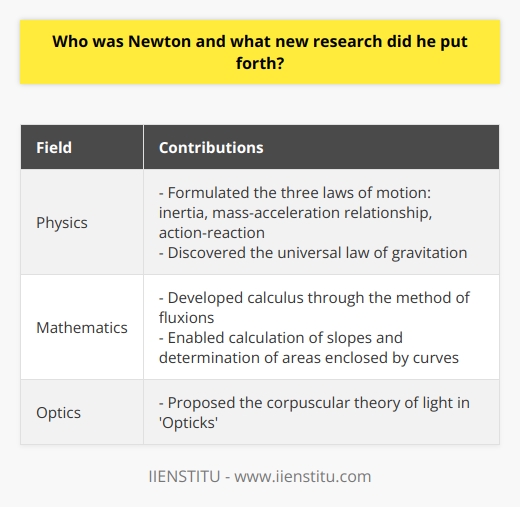
How did Newton prove his theory of gravity?
Evidence from Newton's Theory
Newton's theory of gravity, known as the Universal Law of Gravitation, primarily relied on empirical evidence rather than mathematical proof. Newton collected and analyzed data, compared qualitative relationships, and incorporated previous findings to demonstrate the validity of his theory.
Astronomical Observations
One significant source of evidence for Newton's theory of gravity came from astronomical observations, particularly those of the planets in our solar system. He studied the movements and orbits of celestial bodies, such as the Moon, Earth, and other known planets. By analyzing the data on their position and motion over time, Newton was able to show that their orbital patterns were consistent with his hypothesized gravitational force.
Falling Objects and Pendulum Experiments
Another line of evidence that supported Newton's theory came from experiments conducted on Earth. Newton analyzed the behavior of falling objects of various masses and showed that their acceleration due to gravity was constant. This observation led him to propose that the force of gravity is proportional to the mass of objects. Furthermore, he demonstrated the validity of his theory by comparing the behavior of pendulums, where longer pendulum lengths result in slower oscillations, which accorded with his gravitational theory.
Building Upon Previous Discoveries
Newton's theory of gravity was also supported by building on the works of previous scientists. Earlier works by Galileo Galilei and Johannes Kepler provided essential foundations for developing the Universal Law of Gravitation. Galileo's observations on the motion of falling objects and Kepler's laws of planetary motion helped lay the groundwork for Newton's mathematical description of gravity.
Mathematical Framework
Lastly, to prove his theory of gravity, Newton provided a mathematical framework that quantitatively described the gravitational force between any two bodies. His inverse-square law governing the gravitational force states that the force between two objects is directly proportional to the product of their masses and inversely proportional to the square of the distance between them. This enabled a broad range of predictions and explanations concerning observed phenomena, such as tides and the precession of planetary orbits.
In conclusion, Newton's proof of his theory of gravity relied on a combination of empirical evidence, experimental data, incorporation of previous discoveries, and a robust mathematical framework. These elements allowed him to present a comprehensive and coherent model of the force that governs the motion of all celestial bodies and enabled the development of classical mechanics.
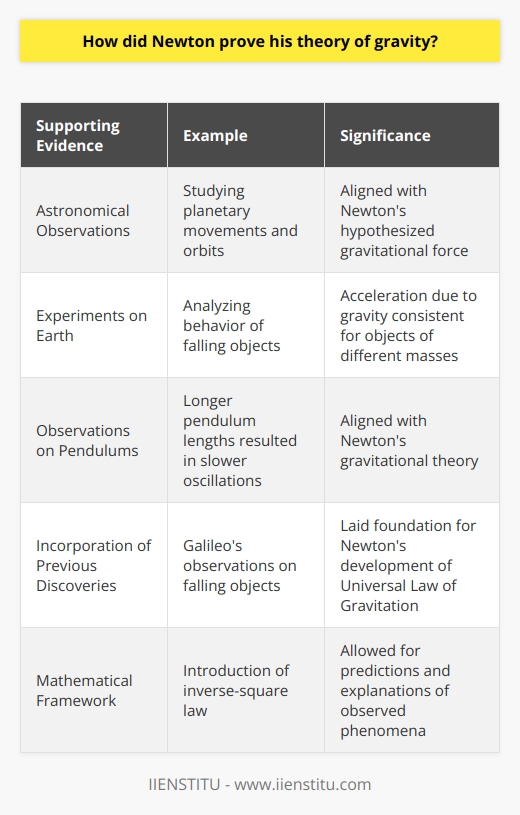
What are the laws of motion in the Scientific Revolution?
Laws of Motion in the Scientific Revolution
Foundation of Classical Mechanics
During the Scientific Revolution, Sir Isaac Newton, a key figure, formulated the three fundamental laws of motion. These laws laid the groundwork for classical mechanics, providing a comprehensive framework to describe the motion of objects and their interactions with forces, which have profound implications in various scientific and engineering fields.
The First Law - Inertia
The first law, also known as the law of inertia, states that an object will remain at rest or in uniform motion in a straight line unless acted upon by a net external force. This concept highlights the inherent resistance of an object to change its state of motion, a property known as inertia. In essence, this law debunked the Aristotelian view that motion requires a force to be maintained.
The Second Law - Force and Acceleration
The second law establishes the fundamental relationship between force, mass, and acceleration. Newton quantified this relationship with the equation F = ma, where F represents the net external force acting on an object, m denotes the object's mass, and a is the resulting acceleration. This principle implies that an object's acceleration will be directly proportional to the net force applied to it and inversely proportional to its mass. Consequently, heavier objects require greater force to achieve the same acceleration as lighter ones.
The Third Law - Action and Reaction
The third law, often summarized as 'for every action, there is an equal and opposite reaction,' asserts that forces always come in pairs. Whenever an object (A) exerts a force on another object (B), object B produces an equal force in the opposite direction on object A. This principle has widespread applications in understanding the mechanics of diverse phenomena, such as rocket propulsion, walking, and collisions.
Implications on Modern Science and Technology
These laws of motion have withstood the test of time and continue to hold true in most everyday situations. They enable us to predict how objects will behave under various circumstances, forming the basis for numerous innovations and technological advancements. Although the advent of quantum mechanics and relativity has revealed limitations within Newtonian mechanics at extreme scales, the laws of motion remain integral to our understanding of the physical world.
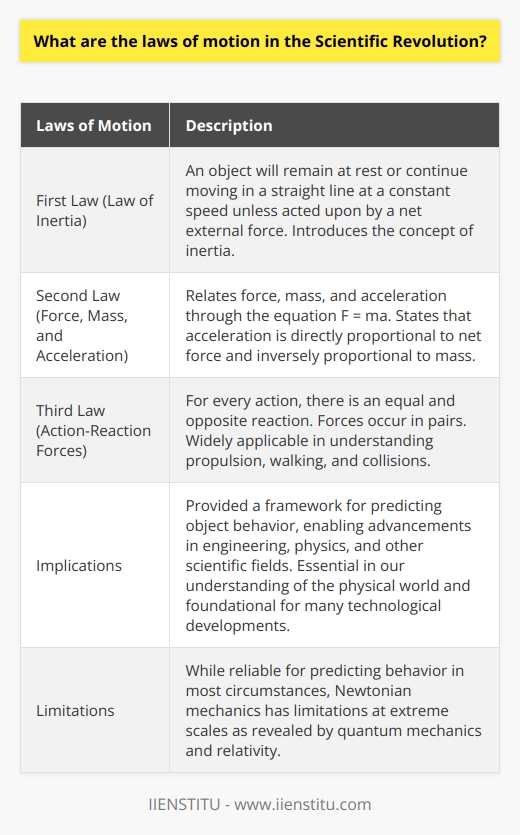
How did Newton's conception of gravity differ from previous understandings during the Scientific Revolution?
**Newton's Revolutionary Ideas**
During the Scientific Revolution, Newton's conception of gravity starkly contrasted previous understandings. Historically, celestial bodies were thought to follow predetermined orbits with the Earth at the center. This idea, popularized by the Ptolemaic geocentric model, was widely accepted until the Copernican Revolution, which displaced Earth from the center of the universe.
**Challenging the Geocentric Model**
Newton's conception of gravity, as described in his Principia Mathematica, departed from the geocentric model. Building upon Galileo's studies of motion and Kepler's laws of planetary motion, Newton synthesized these discoveries to propose a universal law of gravitation. Instead of relying on fixed orbits, Newton contended that the force of gravity acted between every pair of objects with a mass in the universe.
**Gravity as a Unifying Force**
Newton's law of gravitation stipulated that the strength of this force was inversely proportional to the square of the distance between the two objects. It explained the behavior of objects on Earth and celestial bodies in the sky within the same framework. By unifying terrestrial and celestial physics, Newton's conception of gravity provided a deeper understanding of the cosmos and helped establish physics as a discipline grounded in evidence-based analysis.
**Implications for Scientific Knowledge**
By accounting for previously unexplained phenomena, such as the tides and the motion of planets, Newton's conception of gravity expanded the scope of scientific knowledge and refined earlier understandings of motion, matter, and space. His methodology relied on the use of mathematics to represent natural phenomena, further supporting the development of mathematical and scientific thought.
**Conclusion**
In summary, Newton's conception of gravity differed from previous understandings by challenging the geocentric model and by proposing a universal force that connected all objects in the universe. This innovative idea unified terrestrial and celestial physics, established evidence-based inquiry as the cornerstone of scientific discovery, and influenced the trajectory of scientific progress.
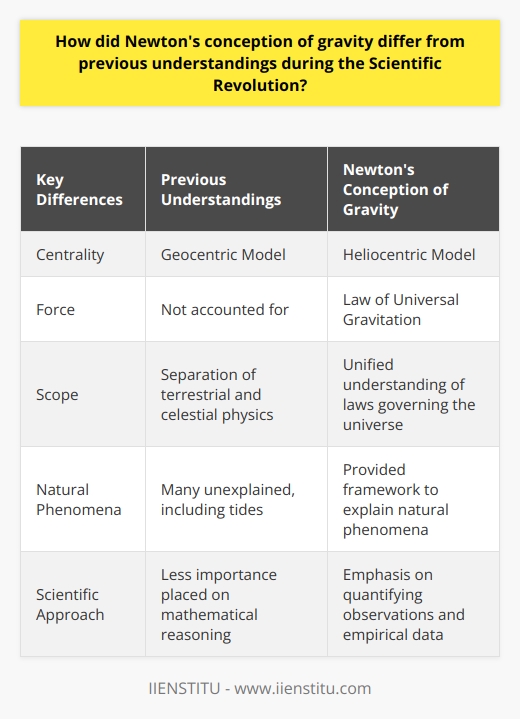
To what extent did Newton's work on calculus propel the development of mathematical analysis in the context of the Scientific Revolution?
The Advent of Calculus
Newton's work on calculus indeed propelled the development of mathematical analysis during the Scientific Revolution. His co-development of calculus, alongside German mathematician Gottfried Leibniz, provided a groundbreaking new method for solving problems in various scientific disciplines.
Key Features of Calculus
Calculus essentially gives us two major tools to work with: derivatives, which allow us to understand rates of change, and integrals, which help us in comprehending areas and volumes. Newton's framework for calculus enabled the analysis of quantities that undergo a continuous change, such as motion and other physical phenomena.
Impact on Mathematical Analysis
Before calculus, mathematical analysis was primarily driven by algebra and geometry. However, calculus offered a new perspective for understanding previously unsolvable problems. For example, the development of calculus allowed for the calculation of planetary orbits and the study of fluid dynamics, both of which were critical to the advances in physics and astronomy during the Scientific Revolution.
Relationship with Other Scientific Developments
Newton's calculus also enhanced other areas of mathematics, such as real analysis and complex analysis. These fields explore the properties of real and complex numbers, respectively, and deal with concepts such as convergence, continuity, and infinite series. The discoveries in these fields fostered further developments in the broader landscape of mathematical analysis.
Interdisciplinary Influence
Furthermore, Newton's work on calculus had a transformative impact on other disciplines within the scientific community. His work prompted advancements in engineering, economics, and biology by providing elegant solutions to a wide array of problems involving optimization, growth rates, and mathematical modeling. Ultimately, this interdisciplinary influence is a testament to the truly revolutionary nature of Newton's innovations in calculus.
In summary, calculus played a significant role in propelling the development of mathematical analysis during the period of the Scientific Revolution. By providing new tools and techniques to analyze problems involving change and motion, Newton's work allowed for both the advancement of existing mathematics and the emergence of new areas of study. Furthermore, the applications of these innovations reached far beyond the realm of mathematics, offering transformative contributions to several other scientific disciplines.

What role did Newton's development of calculus play in advancing the Scientific Revolution?
Role of Calculus in the Scientific Revolution
Foundation of Modern Physics
Newton's development of calculus played an integral role in advancing the Scientific Revolution by providing the mathematical tools needed for quantitative analysis of physical phenomena. This enabled the rigorous description of phenomena like motion, forces, and energy, which laid the foundation of modern physics. Calculus allowed scientists to express complex relations and changes more accurately, leading to more accurate predictions.
Enhancing Scientific Progress
Furthermore, calculus facilitated discussions among scientists during the Scientific Revolution by establishing a unifying language for different disciplines. This allowed researchers to share their findings and collaborate on new discoveries across various scientific fields, thereby, expanding the frontiers of scientific knowledge. As a result, the gradual refinement and articulation of calculus techniques contributed to the rapid progress of the scientific community.
Unlocking Complex Systems
Another significant impact of Newton's calculus is its ability to model and analyze complex systems that were previously intractable. Calculus enabled scientists to study a wide range of issues, from planetary motion to fluid dynamics, by quantifying intricacies and interdependencies involved in such systems. By yielding insights into the behaviors of these systems, calculus laid the groundwork for advancements in both theoretical and applied sciences during the Scientific Revolution.
Supporting Rationalism
Finally, Newton's development of calculus also played a role in promoting rationalism, a vital attribute of the Scientific Revolution. Calculus provided a rational and systematic methodology to solve scientific problems by breaking them down into smaller, manageable computations. By eliminating the need for guesswork and enabling researchers to systematically investigate natural phenomena, calculus contributed to the broader movement of rational inquiry that characterized the Scientific Revolution.
In conclusion, Newton's development of calculus was instrumental in advancing the Scientific Revolution by providing the mathematical foundation for the description and analysis of physical phenomena, facilitating collaboration across disciplines, enabling the modeling of complex systems, and promoting rationalism in scientific inquiry. It supplied a powerful and versatile tool that allowed scientists to delve deeply into understanding the complexities of the natural world and laid the groundwork for future generations of scholars to build upon this knowledge, thus propelling the Scientific Revolution forward.
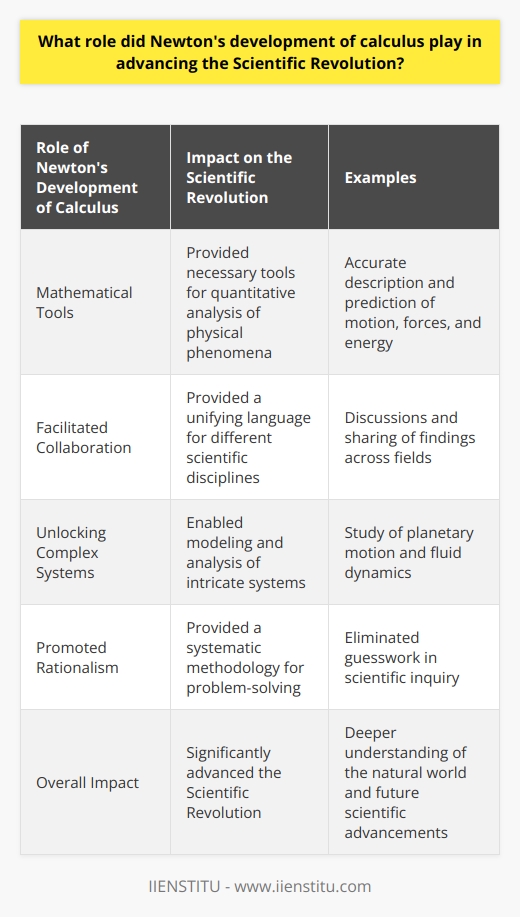
How did Newton's work in optics and his understanding of light contribute to the broader scientific advancements of the Scientific Revolution?
**Newton's Innovative Approach**
Newton's work in optics and his understanding of light played a crucial role in the advancement of scientific knowledge during the Scientific Revolution. His innovative approach to experimentation and critical analysis contributed to a better understanding of fundamental natural phenomena, subsequently benefiting various scientific disciplines.
**Discoveries and Investigations**
Among his most influential discoveries was the realization that white light is composed of multiple colors. This observation stemmed from his prism experiments, which revealed that light could be separated into its constituent colors and recombined to produce white light. This understanding contradicted prevailing beliefs about light's composition and laid the groundwork for the modern study of optics.
**Impact on Optics**
Newton's work in optics profoundly impacted other branches of science as well, including astronomy and microscopy. His insight into how lenses refract light led to the development of the reflecting telescope, which relied on mirrors instead of lenses. This groundbreaking invention vastly improved astronomical observations, as it was less susceptible to chromatic aberration – the distortion of image colors due to lenses.
**Influencing Modern Science**
Furthermore, Newton's theories on light and color heavily influenced other scientists, such as Thomas Young, who used these principles to develop the wave theory of light. Over time, this theory evolved into the current understanding of electromagnetism, an essential component of modern physics. Consequently, the foundations established by Newton's investigations in optics proved indispensable to many scientific advancements.
**Conclusion**
In conclusion, Newton's work in optics and his understanding of light significantly contributed to the broader scientific advancements of the Scientific Revolution. His experiments, discoveries, and theoretical explanations profoundly influenced the development of modern optics and other scientific disciplines, ultimately shaping the course of human knowledge and technological progress.
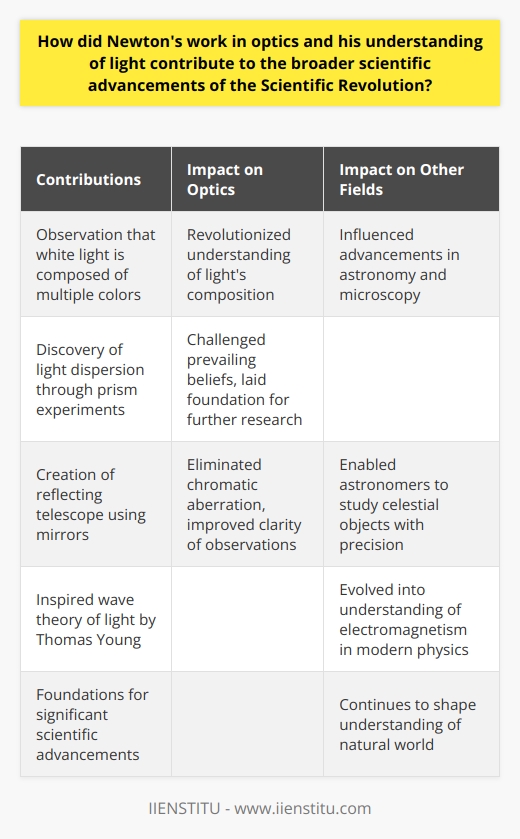
Can you discuss the implications of Newton's laws of motion and his theory of gravitation on the philosophical and scientific thought during the Scientific Revolution?
Implications on Scientific Thought
During the Scientific Revolution in Europe, Newton's laws of motion and his theory of gravitation had profound implications on philosophical and scientific thought. To begin with, Newton's universal law of gravitation promoted a new understanding of the cosmos, replacing the Aristotelian view with a heliocentric model. This paradigm shift in thinking supported the development of modern astronomy and underpinned future advancements in planetary studies.
Effects on Mathematics
In addition to these scientific influences, Newton's laws of motion fostered the development of analytical mathematics, specifically the invention and application of calculus. With calculus, a branch of mathematical reasoning emerged, allowing for the analysis of patterns of change and the study of various physical phenomena. Consequently, calculus became a critical mathematical tool for the exploration of physical and astronomical processes.
Contribution to Enlightenment Philosophy
Moreover, Newton's laws and theory of gravitation contributed significantly to the Enlightenment era, a movement characterized by a pursuit of reason, logic, and empirical knowledge. Newton's work exemplified these ideals and helped to shape the consensus of the time. His scientific methods inspired a focus on the testable, quantifiable, and observable aspects of the natural world. As such, Newton fueled a redirection of philosophy away from speculation and metaphysics, leading to what is now considered modern philosophy.
Impact on Scientific Practice
The implications of Newton's laws of motion and his theory of gravitation also directly affected the scientific practice through the establishment of an empirical approach to research. By utilizing mathematical reasoning, observations, and experimentation, Newton devised explanations suitable for verification and scrutiny. This scientific method cemented the importance of data-driven inquiry in the natural sciences, setting the precedent for future generations of researchers.
Conclusion
In summary, Newton's laws of motion and his theory of gravitation played a vital role in shaping philosophical and scientific thought during the Scientific Revolution. By proposing a new understanding of the cosmos, promoting analytical mathematics, and contributing to Enlightenment philosophy, Newton's work left a lasting impact on the practice of scientific research. This legacy laid the groundwork for future advancements in science, mathematics, and philosophy, ultimately revolutionizing the fields as we know them today.
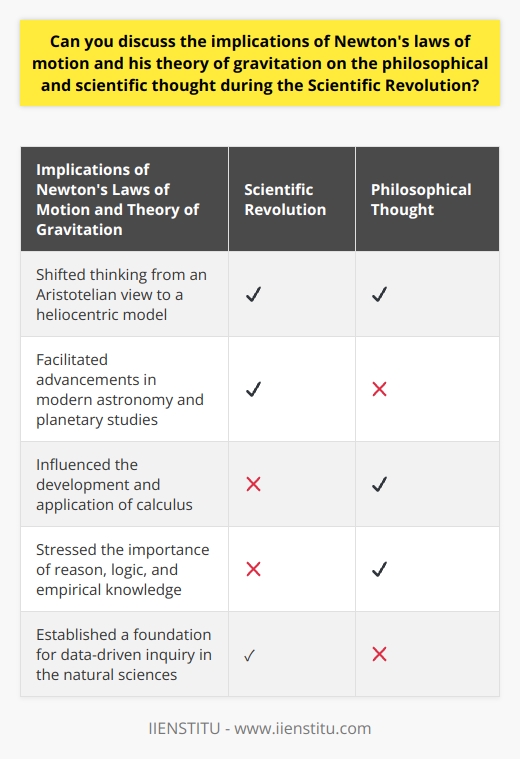
What were the fundamental principles of Newton's laws of motion and their impact on the Scientific Revolution?
**Newton's Laws of Motion**
The fundamental principles of Newton's laws of motion, described in his seminal work 'Philosophiæ Naturalis Principia Mathematica,' include three essential laws. The first law, often known as the law of inertia, states that an object at rest will remain at rest and an object in motion will continue in motion until acted upon by an external force. Newton's second law quantifies the relationship between force, mass, and acceleration as F = ma, where force is equal to mass multiplied by acceleration. The third law dictates that for every action, there is an equal and opposite reaction.
**Impact on the Scientific Revolution**
These laws revolutionized the field of physics during the Scientific Revolution, a period spanning the 16th to the 18th centuries that witnessed major scientific advancements and shifts in the way people understood the natural world. They had a profound impact on the development of various branches of science, such as mechanics, astronomy, and thermodynamics.
**Mechanics and Engineering**
Newton's laws of motion established the field of classical mechanics, providing scientists and engineers with the tools to analyze various mechanical systems. These laws enabled the development of precise mathematical models that predict the motion of objects and the forces involved in any given system. This knowledge has been applied to further advancements in engineering, improving the design of machines, bridges, and other structures.
**Astronomy and Calculus**
In astronomy, Newton's laws laid the foundation for a deeper understanding of celestial motion, helping to explain the motion of planets, moons, and other celestial bodies. These laws enabled the development of celestial mechanics, a branch of astronomy that uses mathematical methods to determine the orbits and interactions of celestial bodies. Furthermore, Newton's creation of calculus, a new mathematical method, made it possible to analyze complex relationships and changes in various physical phenomena.
**Predicting Natural Phenomena**
The understanding of motion gained through Newton's laws also led to the development of predictive models for a range of natural phenomena. For example, scientists applied Newton's laws to understand and predict the behavior of fluids in motion, leading to advancements in fluid mechanics. This knowledge has been applied to a wide range of practical applications, such as weather forecasting, fluid transport, and even blood circulation.
In conclusion, Newton's laws of motion were a significant driving force behind the Scientific Revolution, as they provided a comprehensive framework for understanding and predicting motion across various scientific disciplines. This led to greater innovation in engineering, a deeper understanding of celestial bodies, and the ability to predict a wide range of natural phenomena.

How did Newton's work on optics revolutionize the understanding of light and its properties during the Scientific Revolution?
Newton's Contributions to Optics
Sir Isaac Newton's groundbreaking work on optics during the Scientific Revolution significantly advanced the understanding of light and its properties. His experiments and theories provided a framework for future scientific endeavors and are still influential today.
Dispersion of Light
Newton's famous prism experiment demonstrated that white light is composed of a spectrum of colors. By shining a beam of light through a glass prism, Newton showed that the resulting band of visible colors, called the spectrum, is due to the dispersion of light. This challenged the prevailing belief that colors were intrinsic to objects, proving instead that they arise from the interaction of light with matter.
Particle-Wave Duality
Newton also proposed the corpuscular theory of light, asserting that light consists of tiny particles or 'corpuscles' in motion. This concept contradicted the wave theory of light, developed by Christiaan Huygens, which posited that light is a wave-like phenomenon. Although evidence for the wave nature of light accumulated over time, Newton's particle theory also contributed to the development of the modern concept of wave-particle duality. This reconciles both the wave and particle characteristics of light, now known as photons.
Optical Instruments
Building on his understanding of light, Newton invented the reflecting telescope, which significantly improved upon the refracting telescopes of his time. This innovation utilized mirrors, rather than lenses, to collect and focus light, eliminating chromatic aberration and producing a clearer image. Newton's design revolutionized astronomical observation and paved the way for contemporary telescope technology.
Conclusion
In summary, Newton's work on optics revolutionized our understanding of light and its properties. His groundbreaking experiments and theories elucidated the true nature of light, shedding light on its composition, behavior, and interaction with matter. Furthermore, his contributions to optical instrument development have had a lasting impact on scientific inquiry and helped shape the subsequent course of modern physics.
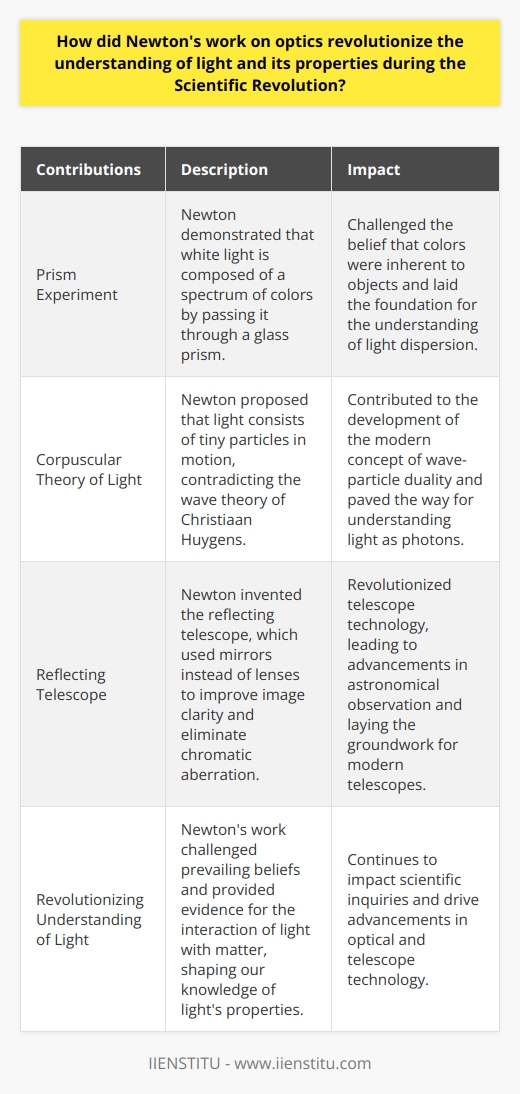
To what extent did Newton's Mathematical Principles of Natural Philosophy shape the subsequent research and discoveries within the Scientific Revolution?
**Influence on Scientific Research**
Newton's Mathematical Principles of Natural Philosophy significantly influenced the subsequent research within the Scientific Revolution. By presenting a mathematical framework to study natural phenomena, Newton allowed innovative thinkers to quantify and prove their theories. Among the fields greatly affected were physics, mathematics, and astronomy.
**Advancements in Physics**
In physics, Newton's three laws of motion were fundamental in shaping the modern understanding of the subject. The formulation of these laws led to the development of classical mechanics, providing methods for engineers and scientists to analyze the movement of objects and the forces acting upon them.
**Mathematical Discoveries**
Newton's invention of calculus revolutionized the field of mathematics, offering a new way to analyze complex problems involving change and motion. His mathematical framework provided scientists and mathematicians with useful tools necessary for analytical research and problem solving. The impact of calculus extended from pure mathematics to physics, enabling further advancements in the study of the universe.
**Astronomical Contributions**
The application of Newton's gravitational theories to celestial bodies allowed for accurate descriptions and predictions of planetary motion. By observing the universal law of gravitation, his contemporaries could explain the motion of heavenly bodies and solidify the heliocentric model of the universe. Newton's work laid the foundation for future astronomers, such as Edmond Halley, who predicted the return of Halley's Comet and discovered the proper motion of stars.
In conclusion, Newton's Mathematical Principles of Natural Philosophy profoundly shaped the scientific research and discoveries that took place during the Scientific Revolution. His groundbreaking contributions to physics, mathematics, and astronomy ushered in a new era of scientific inquiry based on mathematical reasoning and empirical evidence.

What were the driving factors that led to the development of Newton's laws of motion during the Scientific Revolution?
Driving Factors for Newton's Laws
The creation of Newton's Laws largely came about due to a combination of several influencing elements including cultural shifts, mechanical philosophy, and scientific advancements during the Scientific Revolution.
Cultural Shifts
The 17th century Scientific Revolution facilitated cultural shifts. Society began to critically examine traditional knowledge, which opened doors to deep explorations of nature. This shift fostered Sir Isaac Newton's curiosity to investigate nature's behaviors.
Role of The Mechanical Philosophy
The emergence of the Mechanical Philosophy, which perceived the universe as a large-scale machine, also played a significant role. Newton, influenced by this philosophy, saw the potential to explain natural phenomena through mathematical principles. By treating entities like planets as physical objects in a system, he could apply mathematics to predict their behavior.
Scientific Advancement Influences
Then, there were the influences of scientific advancements. With a plethora of new discoveries and theories surfacing, Newton found himself in an environment that encouraged intellectual growth. The advancements in telescope technology promoted a better understanding of the heavens, while Kepler's laws of planetary motion offered mathematical models of the cosmos. This gave Newton new tools and motivation to study motion.
Role of Independent Inquiry
Lastly, Newton's independent inquiry also led to his laws of motion. Newton's self-study allowed him to combine the laws of motion and universal gravitation to predict motions of celestial bodies, which had never been achievable previously. His keen intellect and insights greatly contributed to the development of these laws.
In conclusion, these intertwined factors of cultural shifts, the spread of mechanical philosophy, scientific advancements, and Newton's independent learning created the ideal environment for Newton's Laws of motion to develop. They collectively formed the DNA for the birth of Newton's revolutionary laws of motion.
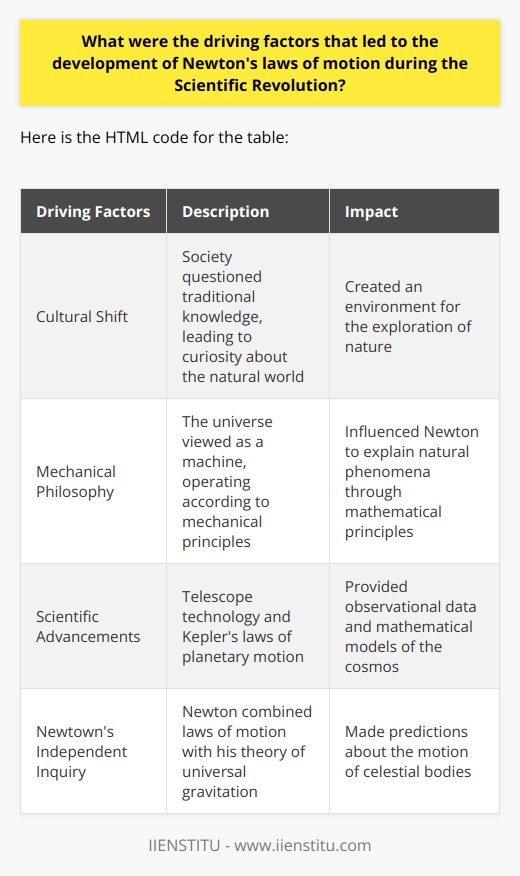
How did Newton's invention of the reflecting telescope contribute to the expansion of knowledge in astronomy and further the scientific advancements of the period?
Innovation of Reflecting Telescope:
Newton's invention of the reflecting telescope revolutionized the field of astronomy. Spotting a crucial drawback in refracting telescopes, Newton designed the reflecting variant. He embedded a mirror within the telescope. This seemingly simple addition augmented our knowledge in astronomy immensely.
Astronomical Knowledge Enhancement:
The distinguishing feature of Newton's telescope was its capacity to eliminate chromatic aberration. This advanced scientific understanding of celestial bodies. Moreover, enhanced visibility allowed scientists to perform more detailed space observations. Consequently, the reflecting telescope paved the way for in-depth, accurate astronomical study contributing significantly to expanded knowledge in the field.
Impact on Scientific Advancements:
In addition, Newton's telescope had profound implications for scientific advancements during that period. His method of using curved mirrors instead of lenses eliminated color distortion. Thus, it allowed for a more accurate examination of distant celestial objects. This breakthrough advanced the study of stars and planets, enabling significant scientific discoveries to occur.
Furthermore, Newton’s invention furnished the foundational concept for some of the most prominent modern telescopes, including the Hubble Space Telescope. These large, high-powered tools of astronomical exploration have significantly broadened our understanding of the universe.
In conclusion, Newton's reflecting telescope represented a critical leap in astronomy, and scientific advancement. The enhanced observational capacity it provided facilitated subsequent discoveries and explorations. This significant contribution continues to influence modern astronomical advancements.

In what ways did Newton's work on universal gravitation contribute to a unified understanding of the cosmos and the laws governing motion, both terrestrial and celestial, during the Scientific Revolution?
Subheading: Newton’s Universal Gravitation
Newton's work on universal gravitation fundamentally altered the way scientists understood the universe. He postulated that every object in the universe attracts every other object with a force. This force depends on the masses of the objects and the distance between them.
Subheading: Contribution to Cosmos Understanding
At the heart of Newton's celestial insights lay his law of universal gravitation. This concept unified the previously separate realms of terrestrial and celestial physics. Newton's revolutionary insight was that the same forces rule the heavens and the earth.
Subheading: Effect on Terrestrial & Celestial Laws
In terms of laws governing motion, Newton established the three basic laws that describe how objects move. Terrestrially, these laws explained perfectly the motion of objects on the earth. Celestially, they could predict the movements of planets and their moons.
Subheading: Role in Scientific Revolution
Newton's work was a key part of the Scientific Revolution. This revolution saw a shift from the classical, Aristotelian physics to a new, mathematical framework. Newton’s work paved the path for this change. His theories became universally accepted, providing a unifying theory of the physical universe.
Subheading: Conclusion
In conclusion, Newton's work on universal gravitation brought about a paradigm shift. It consolidated disparate observations and theories about terrestrial and celestial motion into a unified framework. Newton’s genius lay in his ability to perceive a grand, unifying structure underlying the myriad phenomena of the cosmos. His work remains an indelible part of the edifice of modern science.
